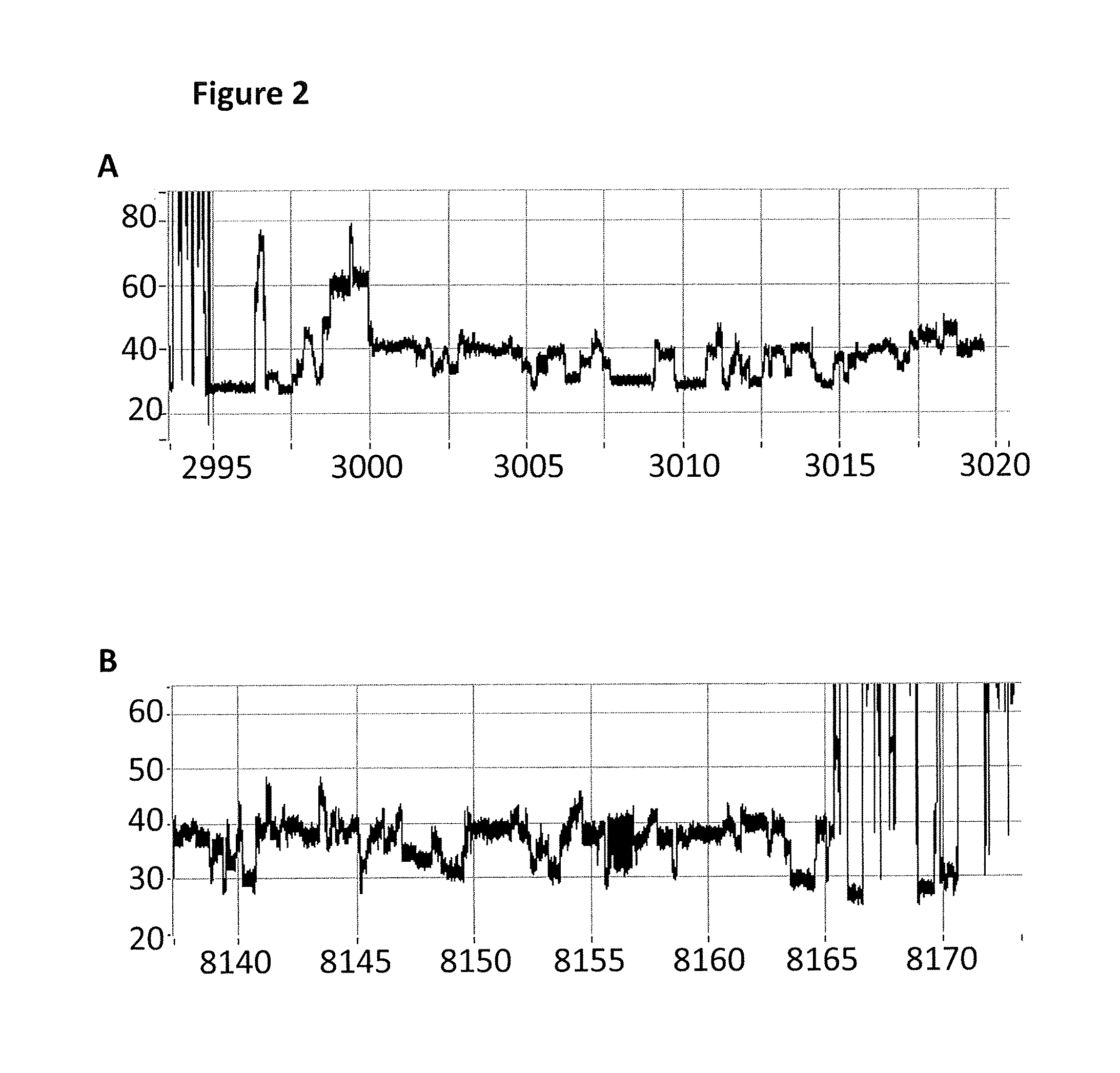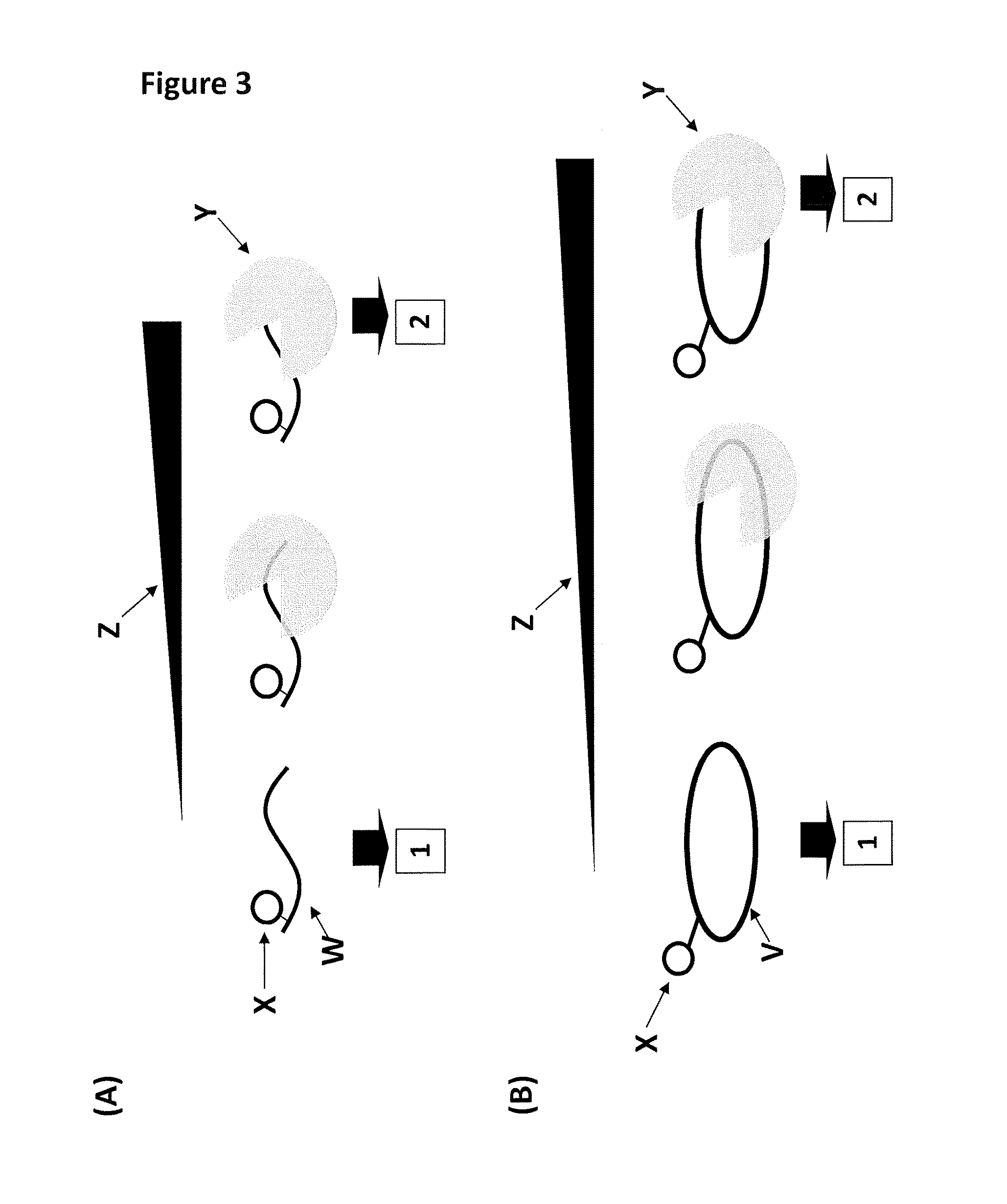Modified helicases
- Summary
- Abstract
- Description
- Claims
- Application Information
AI Technical Summary
Benefits of technology
Problems solved by technology
Method used
Image
Examples
example 1
[0543]This example describes how a T4 Dda—E94C / A360C (SEQ ID NO: 8 with mutations E94C / A360C and then (ΔM1)G1G2) controlled the movement of intact DNA strands through a single MspA nanopore (MS(B1—G75S / G77S / L88N / Q126R)8 MspA (MspA—B2C) (SEQ ID NO: 2 with mutations G75S / G77S / L88N / Q126R).
Materials and Methods
[0544]Prior to setting up the experiment, the Lambda DNA construct (SEQ ID NO: 60 attached by its 3′ end to four iSpC3 spacers which are attached to the 5′ end of SEQ ID NO: 61 which is attached at its 3′ end to four iSPC3 spacers which are attached to the 5′ end of SEQ ID NO: 62, the SEQ ID NO: 61 region of this construct is hybridised to SEQ ID NO: 63 (which has a 3′ cholesterol tether) see FIG. 8 for a diagram of the construct) and T4 Dda—E94C / A360C were pre-incubated together for 15 minutes at 23° C. in buffer (20 mM CAPS, pH 10.0, 500 mM NaCl, 5% Glycerol, 2 mM DTT).
[0545]Electrical measurements were acquired at 20° C. (by placing the experimental system on a cooler plate) fr...
example 2
[0547]This example describes how a T4 Dda—E94C / A360C exhibited tight binding to both linear (SEQ ID NO: 64) and circular (SEQ ID NO: 65) single-stranded DNA. The tight binding of the enzyme was measured using a fluorescence anisotropy-based assay.
Materials and Methods
[0548]Two custom fluorescent substrates were used to assess the ability of T4 Dda—E94C / A360C helicase to bind to linear (SEQ ID NO: 64) and circular (SEQ ID NO: 65) single-stranded DNA. The 44 nt linear single-stranded DNA substrate (1 nM final, SEQ ID NO: 64) had a carboxyfluorescein (FAM) attached to the thymine base at position 37 in SEQ ID NO: 64. The 75 nt circular single-stranded DNA substrate (1 nM final, SEQ ID NO: 65) had a carboxyfluorescein (FAM) attached to a thymine base in SEQ ID NO: 65. As the helicase bound to either fluorescent substrate in a buffered solution (25 mM potassium phosphate, 151.5 mM KCl, pH8.0, 10 mM MgCl2), the fluorescence anisotropy (a property relating to the speed of tumbling of the D...
example 3
[0552]This example compared the helicase-controlled DNA movement of T4 Dda—E94C / A360C with that of TrwC Cba (SEQ ID NO: 66). Both helicases move along the polynucleotide in a 5′ to 3′ direction. When the 5′ end of the polynucleotide (the end away from which the helicases move) is captured by the pore, the helicases work with the direction of the field resulting from the applied potential and move the threaded polynucleotide into the pore and into the trans chamber. T4 Dda was observed to control the translocation of DNA through the nanopore smoothly without the DNA stepping back (i.e. towards its 3′end relative the pore), whereas TrwC Cba resulted in stepping back of the DNA between states as it controlled translocation of the DNA. In this Example, stepping back involves the DNA moving backwards relative to the the pore (i.e. towards its 5′ and away from it 3′ end in this Example). This phenomenon was called slipping in UK Application Nos. 1318464.3 and 1404718.7.
Materials and Metho...
PUM
| Property | Measurement | Unit |
|---|---|---|
| Fraction | aaaaa | aaaaa |
| Electrical conductance | aaaaa | aaaaa |
| Current | aaaaa | aaaaa |
Abstract
Description
Claims
Application Information
 Login to View More
Login to View More - R&D
- Intellectual Property
- Life Sciences
- Materials
- Tech Scout
- Unparalleled Data Quality
- Higher Quality Content
- 60% Fewer Hallucinations
Browse by: Latest US Patents, China's latest patents, Technical Efficacy Thesaurus, Application Domain, Technology Topic, Popular Technical Reports.
© 2025 PatSnap. All rights reserved.Legal|Privacy policy|Modern Slavery Act Transparency Statement|Sitemap|About US| Contact US: help@patsnap.com



